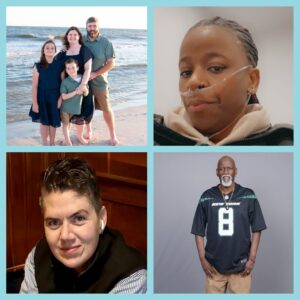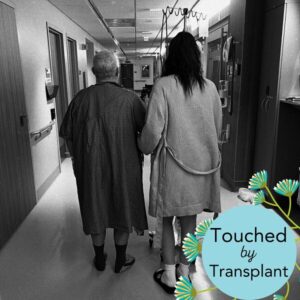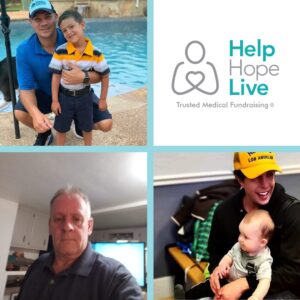Patrick McEntee was diagnosed with cardiomyopathy in 1996. By 2008, he had experienced two strokes and a non-obstructive heart attack. He received an LVAD in 2014 and began fundraising with HelpHOPELive six months after being listed for transplant. In honor of Heart Month, here are Patrick’s observations after a year and a half on the transplant waiting list.

Pat received an LVAD in 2014
The Physical Impact
I was evaluated for transplant at the Cleveland Clinic in August 2014 and again in September 2014. I was admitted to the hospital immediately upon completion of that second evaluation and was officially listed for transplant that month. My LVAD was put in two days later. It was strange because I had walked – struggling to do so, but still walking on my own – to appointments all over the Clinic’s campus that Friday, and doctors thought I would be listed as a low-priority Level 2 on the waiting list. By Monday, they wouldn’t allow me to get out of bed. I didn’t feel any different, but I went with what they told me. Things escalated very quickly.
The LVAD knocked me for a loop. I didn’t quite know what I was in for. I was sedated for three days after the procedure and I spent a few more days in the ICU. I was in the hospital for a month total. I knew I was going for transplant evaluations, but I really had no idea that I would be there for a month. I thought I’d be returning home the same day. I got the LVAD and it was clear I wasn’t going to be able to continue working and living. I had to apply for disability and prepare for transplant.
Financial Challenges
When you go for a heart transplant evaluation, you don’t just see a transplant coordinator. You also see a cardiologist, a bone doctor, a dentist, a dermatologist and more–and there are expenses associated with each. It’s $30 every time I walk up to a doctor’s desk, plus parking and travel: it’s a 3.5-hour drive to Cleveland and 3.5 hours back home every time I have an appointment. I’m there at least once a month, and I’ve been admitted to the hospital twice during regular appointments since the LVAD was put in to help prepare my body for transplant.

Pat faces a 3.5-hour drive to his transplant center
The Role of Fundraising
I’m honestly overwhelmed at the support I’ve been receiving. I’ve had family members, friends, and even friends-of-friends and anonymous donors make significant donations. Most of my fundraising has happened through online sharing and word-of-mouth. The most unnerving thing financially is not really knowing what medications I’ll be on and how much they will cost. Thanks to fundraising, even if I’m looking at $1,000 per month out-of-pocket with prescriptions, I have enough built up that I would be able to cover it for quite a while.
Finding Gratitude
The realization that there are certain things I can’t do is a challenge. Seventy- and 80-year-olds say that, but here I am at 41 saying that myself. But overall, I’m very thankful for the situation that I’m in. I’d love to be completely healthy, obviously, but it is what it is. I’m happy to be able to come and go and do what I want and still have a decent level of independence at this stage.
My wife has been tremendous. She has helped me take it day by day and roll with the changes. She has to be careful now about scheduling her travel for work in case I get ‘the call’ or need her help. It’s a toll that she’s happy to deal with, but it does get in the way of her being able to do what she wants or needs to do at times. For me it’s about staying positive, because I’m surrounded by my wife, my family, my friends and even strangers who are willing to jump in and help out. If you’re a positive person, I think people around you will often respond in that way.
I am grateful for the prayers from thousands of people from all over the country – many people, including strangers, have told me they pray for me daily. It’s truly humbling. My faith has taught me to be grateful for the extra time I have been given in this life, no matter how much more I get. I could easily be dead by now, but I am alive, which I take to mean that God has more for me to learn and accomplish in this life.
Unexpected Benefits
My sister has had similar heart-related issues within the past year. One of the benefits of not being able to work was being able to look out for her and take her to appointments. Beyond that, I’ve started to volunteer with some of the medical centers, talking to patients who are considering an LVAD or have just received one. I explain my experience to them. I’ve really appreciated being able to do that. I see it as almost a ministry, talking to these patients to give them my take on it.
Getting (Too) Comfortable
It’s one thing to say, okay, I’m used to this and this is the new normal. But I have to keep reminding myself that I could get the call at any time. There was a time after the LVAD that I didn’t feel like I was ready to get the call. Today, I still try to imagine what I’ll be doing when I get the call and how I’ll react. Am I going to be able to drop everything and go? If I got the call right now, I’d have to grab a bag and be out the door and tell my wife to meet me up there. It’s a fine line: I want to continue with life and not end up sitting there doing nothing, just waiting.

Pat describes the “fine line” between preparing for transplant and continuing to live life
The Role Of Humor
Some might see my wife and my sense of humor as a bit morbid, but I find that laughing about our situation is helpful. For Christmas, my wife gave me an anatomically-correct plush heart and said, “Until the real thing comes along.” She also gave me a pair of socks with gold hearts and “heart of gold” stitched on them. Friends on Facebook helped me create a cardioversion playlist with songs like “Electric Avenue,” “Kickstart My Heart,” and “We Got The Beat.” A sense of humor is mandatory in dealing with the unknown of the process of waiting for a transplant.

“Until the real thing comes along…”
What To Do While You’re Waiting
The important thing is to keep living your life and doing as much as you can. While I’m not working, I wake up and ask, what is my purpose today? Some days my purpose is to sit on the couch and watch TV. But other days I’ll say, today I’m going to do some writing. Today I’m going to read a book. Today I’m going to the grocery store. Whatever it is that you’re able to do, do it.
Get involved in whatever ways you can in life. For example, through volunteering. I found that very rewarding and helpful. Be willing to give of yourself. A lot of people would agree with me that when you give, you receive. It’s nice to tell your story and hear the stories of others.
Lastly, I would add, stay active. It’s not unusual to gain weight with the LVAD, so exercising as much as possible is incredibly important. I know it’s difficult when you are in heart failure but it’s a way to ensure you can be as strong as possible when the call comes.
Follow Patrick’s story or make a donation in his honor on his HelpHOPELive Campaign Page. Have your own transplant story to tell? Reach out to us on Facebook.
Patrick McEntee was diagnosed with cardiomyopathy in 1996. By 2008, he had experienced two strokes and a non-obstructive heart attack. He received an LVAD in 2014 and began fundraising with HelpHOPELive six months after being listed for transplant. In honor of Heart Month, here are Patrick’s observations after a year and a half on the transplant waiting list.

The Physical Impact
I was evaluated for transplant at the Cleveland Clinic in August 2014 and again in September 2014. I was admitted to the hospital immediately upon completion of that second evaluation and was officially listed for transplant that month. My LVAD was put in two days later. It was strange because I had walked – struggling to do so, but still walking on my own – to appointments all over the Clinic’s campus that Friday, and doctors thought I would be listed as a low-priority Level 2 on the waiting list. By Monday, they wouldn’t allow me to get out of bed. I didn’t feel any different, but I went with what they told me. Things escalated very quickly.
The LVAD knocked me for a loop. I didn’t quite know what I was in for. I was sedated for three days after the procedure and I spent a few more days in the ICU. I was in the hospital for a month total. I knew I was going for transplant evaluations, but I really had no idea that I would be there for a month. I thought I’d be returning home the same day. I got the LVAD and it was clear I wasn’t going to be able to continue working and living. I had to apply for disability and prepare for transplant.
Financial Challenges
When you go for a heart transplant evaluation, you don’t just see a transplant coordinator. You also see a cardiologist, a bone doctor, a dentist, a dermatologist and more–and there are expenses associated with each. It’s $30 every time I walk up to a doctor’s desk, plus parking and travel: it’s a 3.5-hour drive to Cleveland and 3.5 hours back home every time I have an appointment. I’m there at least once a month, and I’ve been admitted to the hospital twice during regular appointments since the LVAD was put in to help prepare my body for transplant.

The Role of Fundraising
I’m honestly overwhelmed at the support I’ve been receiving. I’ve had family members, friends, and even friends-of-friends and anonymous donors make significant donations. Most of my fundraising has happened through online sharing and word-of-mouth. The most unnerving thing financially is not really knowing what medications I’ll be on and how much they will cost. Thanks to fundraising, even if I’m looking at $1,000 per month out-of-pocket with prescriptions, I have enough built up that I would be able to cover it for quite a while.
Finding Gratitude
The realization that there are certain things I can’t do is a challenge. Seventy- and 80-year-olds say that, but here I am at 41 saying that myself. But overall, I’m very thankful for the situation that I’m in. I’d love to be completely healthy, obviously, but it is what it is. I’m happy to be able to come and go and do what I want and still have a decent level of independence at this stage.
My wife has been tremendous. She has helped me take it day by day and roll with the changes. She has to be careful now about scheduling her travel for work in case I get ‘the call’ or need her help. It’s a toll that she’s happy to deal with, but it does get in the way of her being able to do what she wants or needs to do at times. For me it’s about staying positive, because I’m surrounded by my wife, my family, my friends and even strangers who are willing to jump in and help out. If you’re a positive person, I think people around you will often respond in that way.
I am grateful for the prayers from thousands of people from all over the country – many people, including strangers, have told me they pray for me daily. It’s truly humbling. My faith has taught me to be grateful for the extra time I have been given in this life, no matter how much more I get. I could easily be dead by now, but I am alive, which I take to mean that God has more for me to learn and accomplish in this life.
Unexpected Benefits
My sister has had similar heart-related issues within the past year. One of the benefits of not being able to work was being able to look out for her and take her to appointments. Beyond that, I’ve started to volunteer with some of the medical centers, talking to patients who are considering an LVAD or have just received one. I explain my experience to them. I’ve really appreciated being able to do that. I see it as almost a ministry, talking to these patients to give them my take on it.
Getting (Too) Comfortable
It’s one thing to say, okay, I’m used to this and this is the new normal. But I have to keep reminding myself that I could get the call at any time. There was a time after the LVAD that I didn’t feel like I was ready to get the call. Today, I still try to imagine what I’ll be doing when I get the call and how I’ll react. Am I going to be able to drop everything and go? If I got the call right now, I’d have to grab a bag and be out the door and tell my wife to meet me up there. It’s a fine line: I want to continue with life and not end up sitting there doing nothing, just waiting.

The Role Of Humor
Some might see my wife and my sense of humor as a bit morbid, but I find that laughing about our situation is helpful. For Christmas, my wife gave me an anatomically-correct plush heart and said, “Until the real thing comes along.” She also gave me a pair of socks with gold hearts and “heart of gold” stitched on them. Friends on Facebook helped me create a cardioversion playlist with songs like “Electric Avenue,” “Kickstart My Heart,” and “We Got The Beat.” A sense of humor is mandatory in dealing with the unknown of the process of waiting for a transplant.

What To Do While You’re Waiting
The important thing is to keep living your life and doing as much as you can. While I’m not working, I wake up and ask, what is my purpose today? Some days my purpose is to sit on the couch and watch TV. But other days I’ll say, today I’m going to do some writing. Today I’m going to read a book. Today I’m going to the grocery store. Whatever it is that you’re able to do, do it.
Get involved in whatever ways you can in life. For example, through volunteering. I found that very rewarding and helpful. Be willing to give of yourself. A lot of people would agree with me that when you give, you receive. It’s nice to tell your story and hear the stories of others.
Lastly, I would add, stay active. It’s not unusual to gain weight with the LVAD, so exercising as much as possible is incredibly important. I know it’s difficult when you are in heart failure but it’s a way to ensure you can be as strong as possible when the call comes.
Follow Patrick’s story or make a donation in his honor on his HelpHOPELive Campaign Page. Have your own transplant story to tell? Reach out to us on Facebook.











